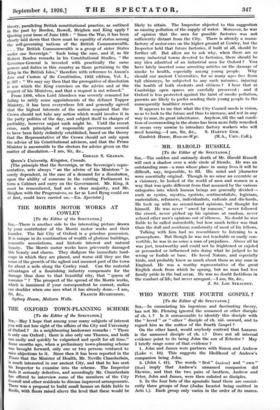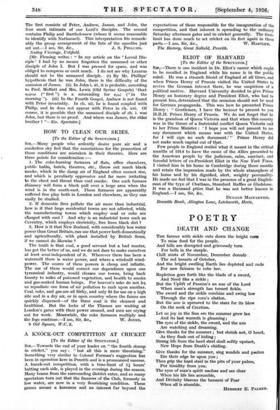WHO WROTE THE FOURTH GOSPEL?
[To the Editor of the SPECTATOR.] SIR,—In enunciating his ingenious and fascinating theory, has not Mr. Fleming ignored the unnamed or other disciple of ch. i. ? Is it unreasonable to identify this disciple with the " loved " or " other " disciple of ch. xiii. onward, and to regard him as the author of the fourth Gospel ?
On the other hand, would anybody contend that Lazarus is the unnamed disciple of ch. i.? Does not all internal evidence point to its being John the son of Zebedee ? May I briefly range some of that evidence ?
1. John and James were partners with Simon and Andrew (Luke v. 10). This suggests the likelihood of Andrew's companion being John.
2. (John i. 41). The words "first" (rpC.n-ov) and " own " (2tos) imply that Andrew's unnamed companion did likewise, and that the two pairs of brothers, Andrew and Peter, John and James, were then enlisted as disciples.
3. In the four lists of the apostolic band there are consist- ently three groups of four (Judas Iscariot being omitted in Acts i.). Each group only varies in the order of its names The first consists of Peter, Andrew, James, and John, the four most intimate of our Lord's disciples. The second. contains Philip and Bartholomew (whom it seems reasonable to identify with Nathanael). This interpretation fits remark- ably the group arrangement of the lists of the apostles just
[Mr. Fleming writes : "In my article on the Loved Dis- ciple' I had by no means forgotten the unnamed or other disciple of John I. But I was pressed for space, and was- obliged to compress or omit much. I do not see why Lazarus should not be the unnamed disciple. (i) By Mr. Phillips' hypothesis that he was John, there is the difficulty of the omission of James. (ii) In John i. 41, it is probable, according to Prof. Moffatt and Mrs. Lewis (Old Syriac Gospels) 'that rparoy (" first ") is a misreading for TINA' (" in the morning "). (iii) In the Fourth Gospel, Andrew is not found with Peter invariably. In ch. Xii, he is found coupled with Philip, and he does not appear with Peter in ch. xxi. Of course, it is possible that the unnamed disciple of ch. i. was John, but there is no proof. And where was James, the elder brother ? "—En. Spectator.]



































 Previous page
Previous page